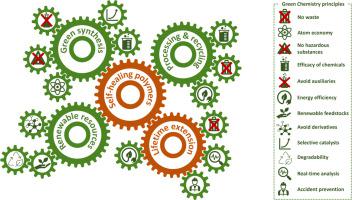当前位置:
X-MOL 学术
›
Prog. Polym. Sci.
›
论文详情
Our official English website, www.x-mol.net, welcomes your feedback! (Note: you will need to create a separate account there.)
Sustainability of self-healing polymers: A holistic perspective towards circularity in polymer networks
Progress in Polymer Science ( IF 27.1 ) Pub Date : 2024-03-26 , DOI: 10.1016/j.progpolymsci.2024.101816 Kenneth Cerdan , Marlies Thys , Aleix Costa Cornellà , Fatma Demir , Sophie Norvez , Richard Vendamme , Niko Van den Brande , Peter Van Puyvelde , Joost Brancart
Progress in Polymer Science ( IF 27.1 ) Pub Date : 2024-03-26 , DOI: 10.1016/j.progpolymsci.2024.101816 Kenneth Cerdan , Marlies Thys , Aleix Costa Cornellà , Fatma Demir , Sophie Norvez , Richard Vendamme , Niko Van den Brande , Peter Van Puyvelde , Joost Brancart

|
Permanent polymer networks present an important sustainability challenge. Irreversible covalent crosslinks impart these materials excellent mechanical properties, thermal and chemical resistance, yet also render them difficult to repair and to recycle. Self-healing mechanisms can extend the lifetime of thermosets and elastomers, improving their durability and making their lifecycle more sustainable. In addition to the lifetime extension, this paper reviews the sustainability of self-healing polymers from a holistic point of view. The entire lifecycle of self-healing polymers is critically assessed with reference to the green chemistry principles and sustainable development. The relation between the self-healing chemistries and the sustainability aspects of each of the phases of the lifecycle are discussed, starting from the feedstocks, monomer functionalisation and polymer synthesis, to processing and manufacturing as well as end-of-life considerations, recycling or (bio)degradation. The review provides a toolbox for the development of more sustainable thermosets, elastomers and their composites. It is of utmost importance to consider the entire lifecycle of self-healing materials, derived products and – by extension – any material or product. The self-healing ability and often related recyclability should primarily reduce the amount of new materials that are necessary to fulfill societal needs, by extending the lifetime of products and maximizing reprocessing into new products. Increasing healing efficiency and the number of healing cycles improves the overall environmental impact relative to the extended service lifetime. Renewable resources derived from biomass, recycling processes or waste streams should be the first choice to create new self-healing polymers. Finally, biodegradability can be considered as a complementary end-of-life scenario upon accidental loss of self-healing polymer to the environment, provided that the biodegradation does not start under the prospected use conditions of the self-healing polymers and products, but can be postponed until contact with stimuli present in the environment.
中文翻译:

自修复聚合物的可持续性:聚合物网络循环的整体视角
永久聚合物网络提出了重要的可持续性挑战。不可逆的共价交联赋予这些材料优异的机械性能、耐热性和耐化学性,但也使它们难以修复和回收。自修复机制可以延长热固性材料和弹性体的使用寿命,提高其耐用性并使其生命周期更加可持续。除了寿命延长之外,本文还从整体角度回顾了自修复聚合物的可持续性。自修复聚合物的整个生命周期根据绿色化学原理和可持续发展进行严格评估。讨论了自修复化学物质与生命周期每个阶段的可持续性方面之间的关系,从原料、单体官能化和聚合物合成开始,到加工和制造以及报废考虑、回收或(生物)降解。该评论为开发更可持续的热固性材料、弹性体及其复合材料提供了一个工具箱。最重要的是要考虑自愈材料、衍生产品以及任何材料或产品的整个生命周期。自愈能力和通常相关的可回收性应主要通过延长产品的使用寿命和最大限度地再加工成新产品来减少满足社会需求所需的新材料的数量。提高愈合效率和愈合周期次数可以改善相对于延长使用寿命的整体环境影响。来自生物质、回收过程或废物流的可再生资源应该是制造新型自修复聚合物的首选。最后,生物降解性可以被视为自修复聚合物意外损失到环境中时的补充寿命终止场景,前提是生物降解不是在自修复聚合物和产品的预期使用条件下开始的,但可以推迟直到接触环境中存在的刺激物。
更新日期:2024-03-26
中文翻译:

自修复聚合物的可持续性:聚合物网络循环的整体视角
永久聚合物网络提出了重要的可持续性挑战。不可逆的共价交联赋予这些材料优异的机械性能、耐热性和耐化学性,但也使它们难以修复和回收。自修复机制可以延长热固性材料和弹性体的使用寿命,提高其耐用性并使其生命周期更加可持续。除了寿命延长之外,本文还从整体角度回顾了自修复聚合物的可持续性。自修复聚合物的整个生命周期根据绿色化学原理和可持续发展进行严格评估。讨论了自修复化学物质与生命周期每个阶段的可持续性方面之间的关系,从原料、单体官能化和聚合物合成开始,到加工和制造以及报废考虑、回收或(生物)降解。该评论为开发更可持续的热固性材料、弹性体及其复合材料提供了一个工具箱。最重要的是要考虑自愈材料、衍生产品以及任何材料或产品的整个生命周期。自愈能力和通常相关的可回收性应主要通过延长产品的使用寿命和最大限度地再加工成新产品来减少满足社会需求所需的新材料的数量。提高愈合效率和愈合周期次数可以改善相对于延长使用寿命的整体环境影响。来自生物质、回收过程或废物流的可再生资源应该是制造新型自修复聚合物的首选。最后,生物降解性可以被视为自修复聚合物意外损失到环境中时的补充寿命终止场景,前提是生物降解不是在自修复聚合物和产品的预期使用条件下开始的,但可以推迟直到接触环境中存在的刺激物。



























 京公网安备 11010802027423号
京公网安备 11010802027423号